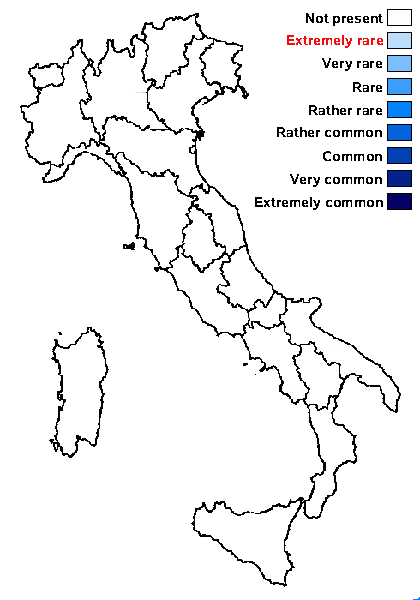Ophioparma junipericola I. Martínez & Aragón
Bryologist, 106, 4: 528, 2003
Synonyms:
Distribution:
Description: Thallus crustose, episubstratic, 0.23-0.35 mm thick, yellowish green, partly granulose, the granules 0.05-0.1 mm in diam., partly areolate, the areoles up to 0.2 m wide, often forming more than 15 cm wide patches, developing on a well-visible, white hypothallus. Cortex 20-35 µm thick of densely entangled hyphae, inspersed with colourless granules; algal layer well-delimited, 40-75 µm thick; medulla of loosely entangled hyphae. Apothecia common, lecanorine. up to 3.5 mm across, with a flat to convex, finally often rugulose, red-brown to brick-coloured disc, and a thin, often flexuose, finally excluded thalline margin, and a thin, finally excluded parathecial ring concolorous with disc. Epithecium red-brown, 15-25 µm high, K+ blue turning violet; hymenium yellowish, 55-75 µm high; paraphyses simple to very rarely sparingly branched, 1-1.5 µm thick, the apical cells with lumina of 1.5-2 µm; hypothecium grey due to the presence of small crystals, 110-160 µm high. Asci 8-spored, clavate, with a shallow, uniformly K/I + blue apical dome, lacking a distinct ocular chamber or apical cushion, Ophioparma-type. Ascospores 3-septate, hyaline, acicular-fusiform, arranged parallel to the long axis of the ascus, straight or slightly curved, 44-75 x 2-3.5 µm. Pycnidia red-brown and K+ blue turning violet near the ostiole, appearing black from above, the wall brown. Conidia bacilliform, 6-9.5 x 1.2-2 µm. Photobiont chlorococcoid. Spot tests: cortex K+ pale yellow, C+ pale yellow, P-; medulla K+ yellow-orange, C-, KC+ yellow-orange, P+ yellow-orange, UV+ glaucous white. Chemistry: thallus with usnic and divaricatic acids. Epithecium and pycnidial ostioles with haemoventosin. Note: a species described from the Parameras of Central Spain, where it was found on lignum of Juniperus thurifera, mostly in the montane belt. It should be looked for in continental areas of Mediterranean Italy (e.g. Central Sardinia). See also note on O. aff. rubricosa.
Growth form: Crustose
Substrata: lignum
Photobiont: green algae other than Trentepohlia
Reproductive strategy: mainly sexual
Subcontinental: restricted to areas with a dry-subcontinental climate (e.g. dry Alpine valleys, parts of Mediterranean Italy)

Predictive model
Growth form: Crustose
Substrata: lignum
Photobiont: green algae other than Trentepohlia
Reproductive strategy: mainly sexual
Subcontinental: restricted to areas with a dry-subcontinental climate (e.g. dry Alpine valleys, parts of Mediterranean Italy)

Predictive model
 Index Fungorum
Index Fungorum
 GBIF
GBIF

